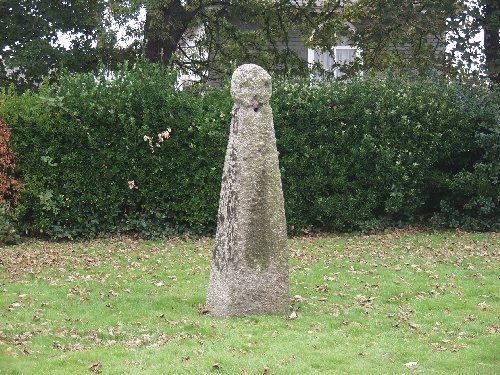



Mên Cadoar in Camborne Churchyard. Photo taken on 19 June 2009. © Chris Bond.

Mên Cadoar in Camborne Churchyard. Photo taken on 19 June 2009. © Chris Bond.

Mên Cadoar in Camborne Churchyard. Photo taken on 19 June 2009. © Chris Bond.

nice lean!

This stone was indeed moved in Edwardian times from its old site on the boundary between Gwinear and Gwithian Parishes at Connor Downs. It was actually moved on All Saints Day, 1 November 1904, by permission of the local landowner of the Rosewarne Estate, Mr Van Grutten. The present pronounced lean of the stone towards the east, as shown in the photograph by Alan S, is due to the falling of a large tree from the hedge on the Churchyard boundary wall just to the west. There is a local tradition that each of the dots on the panels of the shaft of the stone represents the life of one man killed at a great battle at Reskajeage on the North Cliffs near Camborne. In 1613 in the statement of local Parish bounds it is called “Meane Cadoarth” and was referred to as “a Long Stone called Meane Cadoar” in 1651.
Funny one this....missing from most standing stone literature, but well known to those into Dark Ages stone crosses. It is in fact a menhir which stood on the parish boundary between Gwinear and Gwithian until 1907, when it was moved to its current position in Camborne churchyard. Local historians hold the opinion that it is a prehistoric menhir which was converted into a cross in the 11th or 12th century........this is denoted by the very small and crude crosshead which has been fashioned by tapering the neck of the 6ft plus menhir, then letting it flare out again. The decoration of the crosshead is equally crude, and to all intents and purposes, it still looks like the standing stone it obviously is.OK, it’s out of its original position, but it’s a “maen” nevertheless, and deserved of recognition............
T Dexter, in ‘Civilisation in Britain 20000bc’, published in 1931 put this stone forward as possible evidence that Britain was colonised by the ancient Egyptians! Purely on the basis of its pyramidal shape, and the fact that the head is round – thereby being a ‘sun worship’ stone.















































































